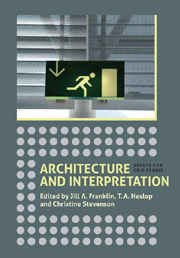Book contents
- Frontmatter
- Contents
- List of Illustrations
- Preface: In Appreciation
- List of contributors
- 1 Introduction
- Incitements to Interpret in Late Antique and Medieval Architecture
- Authors and Intentions
- 146 Home Sweet Mammoth: Neuroarchaeology and the Origins of Architecture
- 163 Constantine and Helena: The Roman in English Romanesque
- 176 For Their Monuments, Look about You: Medieval Masons and their Tombs
- 192 Baxandall's Bridge and Charles IV's Prague: An Exercise in Architectural Intention
- 221 Imitation as a Creative Vehicle in Michelangelo's Art and Architecture
- 242 The ‘Façade Problem’ in Roman Churches, c. 1540–1640
- Architecture beyond Building
- Index
146 - Home Sweet Mammoth: Neuroarchaeology and the Origins of Architecture
from Authors and Intentions
Published online by Cambridge University Press: 05 April 2013
- Frontmatter
- Contents
- List of Illustrations
- Preface: In Appreciation
- List of contributors
- 1 Introduction
- Incitements to Interpret in Late Antique and Medieval Architecture
- Authors and Intentions
- 146 Home Sweet Mammoth: Neuroarchaeology and the Origins of Architecture
- 163 Constantine and Helena: The Roman in English Romanesque
- 176 For Their Monuments, Look about You: Medieval Masons and their Tombs
- 192 Baxandall's Bridge and Charles IV's Prague: An Exercise in Architectural Intention
- 221 Imitation as a Creative Vehicle in Michelangelo's Art and Architecture
- 242 The ‘Façade Problem’ in Roman Churches, c. 1540–1640
- Architecture beyond Building
- Index
Summary
THERE ARE many possible ‘origins of architecture’. Other creatures make homes that have something of the substance, organization and complexity of buildings made by humans, but in almost all cases their layout is largely the product of behaviours which are manifested by all members of the species, being coded for in the species’ distinctive genetic material. Natural selection means that all members of the species share DNA which codes for the growth of particular neural resources, which then assure the development of those distinctive behaviours which are essential for the species’ survival. The building of a semi-permanent nest by a particular bird or bee species and the construction of a mound by termites are examples of such behaviours. The DNA of other creatures, for whose survival a semi-permanent home is not essential, carries no such coding. Homo sapiens is one such creature, and there are still today human populations which only occasionally construct a shelter. This is, however, increasingly unusual; most human populations make constructions which are far more complex and substantial than those made by any other animals. It is such complex and substantial structures that in European languages are dignified by the designation ‘architecture’, and it is the origin of such structures which is the concern of this paper.
- Type
- Chapter
- Information
- Architecture and InterpretationEssays for Eric Fernie, pp. 146 - 162Publisher: Boydell & BrewerPrint publication year: 2012



